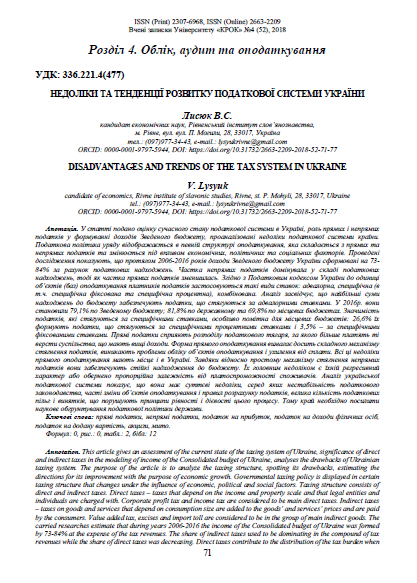DISADVANTAGES AND TRENDS OF THE TAX SYSTEM IN UKRAINE
DOI:
https://doi.org/10.31732/2663-2209-2018-52-71-77Keywords:
direct taxes, indirect taxes, income tax, profit tax, VAT, excise, tollAbstract
This article gives an assessment of the current state of the taxing system of Ukraine, significance of direct and indirect taxes in the modeling of income of the Consolidated budget of Ukraine, analyses the drawbacks of Ukrainian taxing system. The purpose of the article is to analyze the taxing structure, spotting its drawbacks, estimating the directions for its improvement with the purpose of economic growth. Governmental taxing policy is displayed in certain taxing structure that changes under the influence of economic, political and social factors. Taxing structure consists of direct and indirect taxes. Direct taxes – taxes that depend on the income and property scale and that legal entities and individuals are charged with. Corporate profit tax and income tax are considered to be main direct taxes. Indirect taxes – taxes on goods and services that depend on consumption size are added to the goods’ and services’ prices and are paid by the consumers. Value added tax, excises and import toll are considered to be in the group of main indirect goods. The carried researches estimate that during years 2006-2016 the income of the Consolidated budget of Ukraine was formed by 73-84% at the expense of the tax revenues. The share of indirect taxes used to be dominating in the compound of tax revenues while the share of direct taxes was decreasing. Direct taxes contribute to the distribution of the tax burden when the layer of the society with greater income is charged with greater tax. The form of direct taxing requires a complicated mechanism of tax collection as there are problems with the accounting of the objects of taxation and their avoidance of payment. All this taxation drawbacks hold a place in Ukraine too. Due to the simple mechanism of tax collection indirect taxes provide a stable income to the budget. Their main drawback is their regressive character or inversely proportional dependence on consumers’ solvency. The analysis of Ukrainian taxing system shows that it has major drawbacks among which are the instability of taxing legislation, frequent changes of the objects of taxation and taxes calculation rules as well as a high quantity of tax privileges.
Downloads
References
Алімпієв Є. В. Фінансово-монетарна трансмісія у державному регулюванні економіки: монографія. Кам’янець-Подільський, 2013. с. 96-108.
Василик О. Д., Павлюк К. В. Бюджетна система України: підручник. Київ : Центр навчальної літератури, 2004. с.142-151.
Загорський В. С. Бюджетно-податкова система України: теорія і практика: монографія. Київ, 2006. – 304 с.
Льовочкін С. В. Макроекономічна стабілізація в Україні у контексті економічного зростання: монографія. Київ, 2003. с. 37-56, 180-182.
Радіонова І. Ф. Макроекономіка: теорія та політика : підручник. Київ : Таксон, 2004. с. 177-190.
Соколовська А. М. Податкова система держави: теорія та практика становлення : підручник. Київ : Знання-Прес, 2004. 454с.
Лазебник Л. Л., Федосов В. М. Теорія фінансів : підручник. Київ : Центр учбової літератури, 2010. с. 30, 309-313.
Юшко С. В. Використання податкової ставки як інструменту забезпечення зростання доходів бюджету України. Фінанси України : журнал. 2018. №2. с. 109-119.
Податковий кодекс України. – Київ. ДП «ІВЦ ДПА України», 2010. 336с.
Офіційний сайт Державного комітету статистики України. URL : http//www.ukrstat.gov.ua (дата звернення 13.09.2018).
Офіційний сайт Міністерства фінансів України. URL : http//www.minfin.gov.ua (дата звернення 13.09.2018).
Якушик І.Д. Податки в країнах світу: довідник. Київ, 2004. 480 с.


